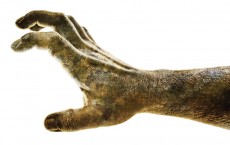 Social Sciences
Social Sciences
Zombies, Pirates and Voodoo

From the classic horror flick Night of the Living Dead to Brad Pitt’s World War Z and beyond, zombies have been on a hair-raising mission to hunt us down and eat our brains.
But the movie versions are just myths. The reality of zombies is far more terrifying.
Wait—don’t turn the page just because you read “zombies” and “reality” in the same sentence.
Anthropology professor Philip Scher‘s focus on the Caribbean region and its cultural identity includes topics that have long captured our collective imagination: pirates, zombies and voodoo. But for Scher, the truths behind these touchstones of Caribbean history are far more interesting than the fictions perpetuated in popular culture.
Pirates, for example, are characterized as vicious or bungling, wild-eyed and wild-haired, sailing the seven seas in humongous galleons flying the skull and crossbones.
While that depiction can be traced to a golden age of piracy in the Caribbean in the 1700s, it bears little resemblance to the actual pirates of that era. Although capable of brutality, Caribbean pirates were often nonviolent and could be quite disciplined—various rules were enforced to preserve order and cleanliness, given a pirate ship had no safe harbor to which it could turn when in distress.
Piracy offered the poor and disenfranchised upward mobility, Scher says—the pay was better than most jobs in the colonies and the democratic approach to ship governance meant that even the lowliest mariner had a say. There was even an insurance plan: You were compensated if, say, during battle you lost an eye or a hand.
Piracy was a form of rebellion against colonial rule by Spain and others. “The lower class was very aware of the way that the cards were stacked against them,” Scher said. “They were signing their own death warrant by becoming pirates, but the prospect of living free was more attractive to them than living other ways.”
Zombies, meanwhile, are typecast in pop culture as attackers. But in Haiti, no one is afraid of being attacked by a zombie—they’re afraid of becoming one.
Although Scher makes no claims about “proof” of zombies, he notes that scholars have looked closely at the claim that there may have been individuals who, at the hands of voodoo priests, were surreptitiously administered a toxic powder, usually through abraded skin. This purportedly rendered them immobile and uncommunicative—seemingly dead.
Most of the scientific evidence, however, does not seem to support the claim. What is more important to Scher is the idea of zombification. The power this concept holds in the imaginations of Haitians speaks to their very real history of enslavement under the French and their continuing feelings of powerlessness as a poor nation.
In a nation where the threat of being forced to serve another was all too real, talk of “zombies” or “ghosts” may have functioned as a way to ensure order, Scher says, i.e. “behave yourself, don’t alienate yourself from the community, or you might get taken away.”
Scher has also unearthed a fascinating history of voodoo, or “vodou” in the region.
Voodoo is typically characterized in North America as a nefarious and irrational belief in magical powers, used to harm. In truth, voodoo practitioners are “primarily concerned with doing good,” Scher said.
In Haitian vodou, physician and patient seek help from a world of spirits through prayers, offerings, devotional objects, ceremonies and ritual foods such as fowl.
Scher argues that our approach to health is not so different from that of the vodou priest or priestess. But, while stricken Americans looking for answers might end up in a doctor’s office, on a psychologist’s couch or in a philosophical debate, the vodou priest offers all three services under one roof.
“They know how to heal medicinally,” Scher said. “But they’re psychologists because they understand that you can’t be healed unless your mind is healthy. And as philosophers, they’re also imparting the right moral behavior.”
―Matt Cooper


 Twitter
Twitter Facebook
Facebook Forward
Forward